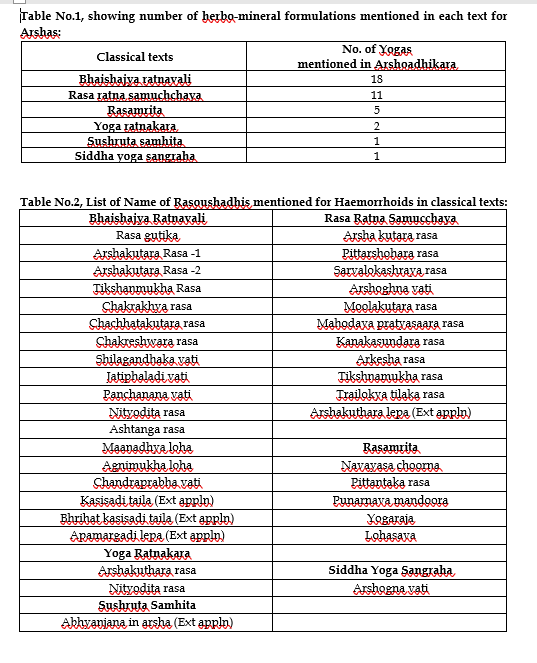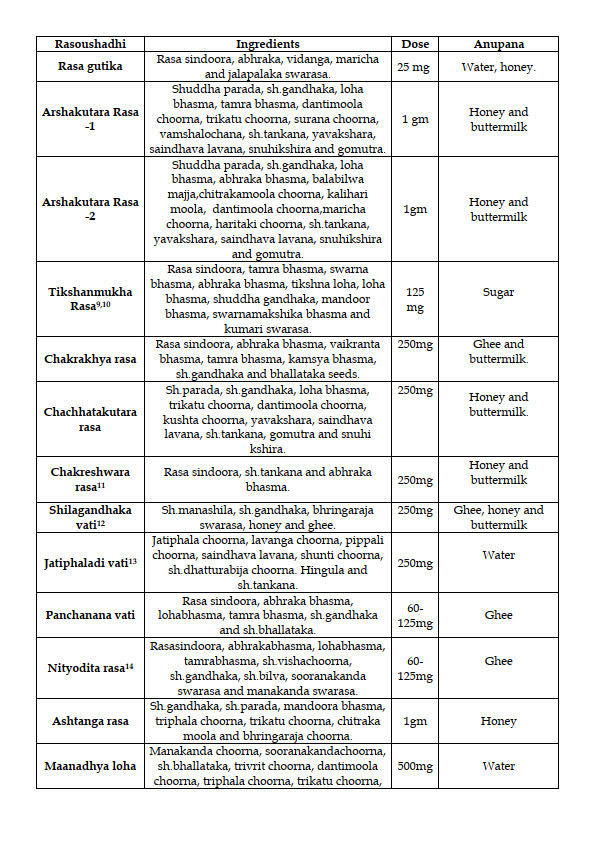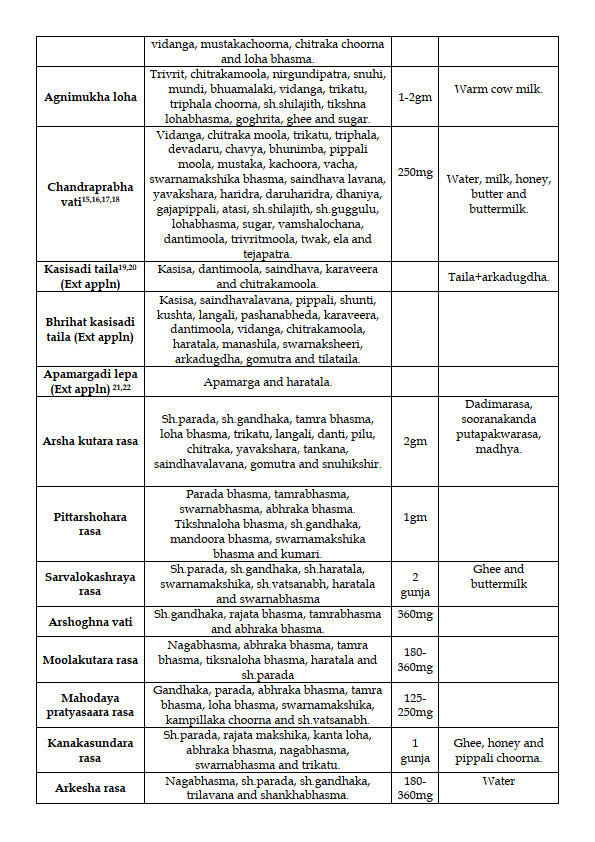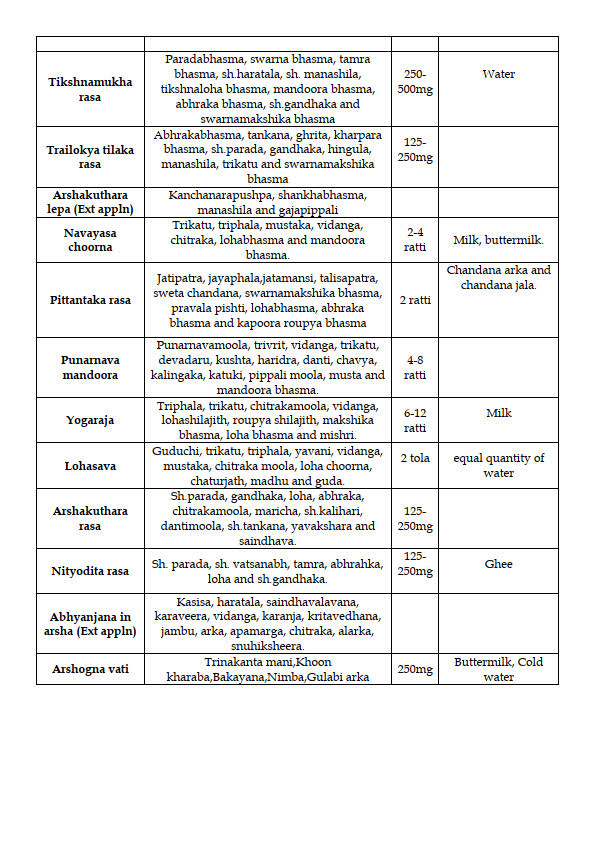Review Article
Year: 2020 |Volume: 1 | Issue: 9 |Pages: 339-350
Review of Rasoushadhis [Herbo-mineral Preparations] for Haemorrhoids
About Author
Correspondence Address:
Dr. Ahalya S Principal, Government Ayurvedic Medical College, Bangalore, Karnataka Email: ayursathishhs@gmail.com
Date of Acceptance: 2020-12-23
Date of Publication:2020-11-07
Article-ID:IJIM_44_01_20 http://ijim.co.in
Source of Support: NIL
Conflict of Interest: NIL
How To Cite This Article: Ahalya S, Mamatha S, Sathish HS. Review of Rasoushadhis [Herbo-mineral Preparations] for Haemorrhoids. Int. J Ind. Med. 2020;1(9):339-350
Abstract
In the clinical practice we usually come across with the patients suffering with Arhsas requesting for non surgical conservative management of the disease. There are various forms of conservative management, yet the oral medication tops the list of preferences. Ayurveda proposes numerous oral medications comprising of both herbs and herbo mineral preparations [Rasoushadhi]. This review study details the rasoushadhis documented in six treatises of Ayurveda and found 38 preparations listed in them were studied.
Keywords: Rasoushadhi, Arsha, Bheshaja
Introduction
Arshas (Haemorrhoids) is a very common anorectal condition defined as the symptomatic enlargement and distal displacement of the normal anal cushions. They affect millions of people around the world, and represent as one of the medico-surgical and socioeconomic problem.1
Management of this condition is through either conservative or surgical approach, patients are always apprehensive about surgical correction of this ailment, they constantly prefer conservative management. The management of Arshas is purely based on the degree of the condition as detailed in the literature2,3,4 The treatment modality is classified as Bheshaja [Medicinal], Shastra [Surgical], Kshara [Chemical cautery] and Agni [Thermal cautery]. Medicinal mode is the most preferred and economical among other modes of treatment. Numerous herbal and herbo-mineral preparations cited in Ayurvedic texts, many of them are used extensively in clinical practice.5,6,7,8 There may be many formulations mentioned and on initial evidence all may appear as same, but only on avid reading it is perceived that every classical combination is contrived with their own set of principles and objectives to combat a disease and its associated complications/symptoms. Among all formulations, the one containing mineral medicines are considered superior for the reason that, their particle size being in micro -nano meter and their abiding quality, bestow rapid and prolonged results. Henceforth, this paper is an attempt to screen and review the various Rasoushdhis mentioned in classical texts.
Objective
To screen and review the Rasaoushadhis cited in Ayurvedic texts for Haemorrhoids with special reference to pharmacological actions.
Materials & Method:
Screening and Review of six treatises of Ayurveda –Bhaishjya Ratnavali, Rasa ratna samucchaya, Rasamrita, Yoga ratnakara, Sushruta samhita and Siddha yoga sangraha.
Method – Hand Search
Observation and Discussion:
Ayurveda has been embodied with huge literary contributions from many Acharyas. Among them all, the reason to take only these books are; Bhaisajya Ratnavali, a literature of 19th C is relatively applicable to current period. The text discusses Rasaoushadhis in detail and gives it a pivotal position. Rasa ratna samuchchaya, is an authentic text of Rasa shastra and contains detailed descriptions of various complex metallurgical processes. Disease wise description of rasa formulations are written precisely. Yoga ratnakara compiled work and masterpiece of Indian medical system in terms of both disease and treatment. Sushruta samhita, the treatise is the first and authentic book of Ayurveda belonging to surgical domain. The Compendium of Sushruta is one of the foundational texts of for all medico surgery cases. Rasamrita -The text Rasamritam is full of practical therapeutic use of different Rasa Dravyas and their processing techniques. As time went on, there was increase of diseases and decrease of classical knowledge. Hence the Ayurveda Martanda Shri Y.T.Acharya has come up with this literature after adopting the scientific and practical knowledge for alchemical methodologies, thereby placing the rasa dravyas at top in scrutiny. Siddha yoga sangraha, is the doctrine prepared for beginners.This book is an excellent compilation of yogas which are easy to prepare and have given proven effects in daily practice.
In total there are 38 number of rasa yogas of Arshoadhikara found in six classics. However, only few are available in market currently.
The market available few drugs are not completely enough to fulfil all the demandable conditions of the disease. This is the reason why texts have given multifold combinations of drugs. Pharmacies are to be encouraged to come out with these yogas for betterment of treatment. Henceforth it becomes essential to learn and scrutinise all the yogas w.r.t rasa dravyas.
Numbers of rasa yogas mentioned in Arshoadhikara of each text are enlisted below-

table 1,2

table 3

table 3

table 3
Discussion
Ayurvedic classics opine, Arshas Haemorrhoids is due to impairment of agni [Digestive fire] vikrutijanya vyadhi, wherein constipation is a frequent addition to vikruti. 23 Hence treatment always initiates with correction of agni with Deepaka, Pachaka and Vata-mala anulomaka dravyas. Research works reveals that, the abnormal dilatation and distortion of the vascular channel, together with destructive changes in the supporting connective tissue within the anal cushion, is a paramount finding of hemorrhoidal disease. They also attribute involvement of ANS and Genetic factor for the condition. 24
Above said pathology is reiterated as Khavaigunya in classics which could be inherited (Genetic) or acquired (Disturbed metabolism) and manifest as Dilated Arterio venous plexus, Damaged anal cushion and weak anal sphincter.
Considering facts of pathology and manifestations, an axiom could be formed to treat arshas :
- Restore agni-deepana, Pachana – Restoring digestive fire to normalcy and improve the metabolic activity.
- Regulate bowel habit-Anulomana/Grahi (as condition demands) – Regular emptying of the bowel as per the biological cycle, constitution of an individual
- Due to inert properties of mineral compounds, the size of the pile mass gets shrunken, Sira balya (Venotonicity) improves the tonicity of vascular intima and due to scarifying activity the mucosal prolapsed of the dilated haemorrhoidal plexus of veins is rectified.
- Correct Khavaigunya25 [Weakness of any bodily channel or Srotas]-
Discussion on Pharmacological properties of Rasa dravyas which are part of classical formulations mentioned in above texts: 26,27,28,29,30
- Rasa sindhura31,32,33-Arshohara,Snayu balya, Kaphavatahara34
Hence Rasa Sindura is incorporated to scrape off deep rooted, chronic pile mass and to correct Khavigunya of anal cushions and sphincter
- Tamra35,36- Lekhana, Saraka, Mamsa dushanahara, Increases Arterial pressure. Hence Tamra yukta yogas [Copper containing preparations] should not be given for more than 21 days and contraindicated in bleeding and Hypertension conditions. 37,38,39,40
- Abhraka41 –Yogavahi-Enhances properties of fellow drugs without losing its own, Nadi balya (Regulates and strengthens Nadi)Facilitates in Strengthening of Snayu, Sira, Helps to check bleeding, Hastens post surgery healing but not a direct drug to treat Arshas. Hence Abhraka yukta yogas or as individual could be administered to correct ANS which is part of pathology in both Genetic And Acquired cause & repair anal sphincter
- Loha, Mandura42, 43 -Rakta prasadana-Improves circulation and nourishes all components of blood, Sira balya (Strengthens walls of blood vessels) Hence this is advised in correcting Dilated Arterio venous plexus, Repair damaged anal cushion
- Gandhaka44,45 -Udara shuddhi, Mrudu virechana, Daha shamaka, corrects intestinal flora, Increases cell permeability
Hence a drug to include for arshas which has its root cause as disturbed metabolism and improper life style
- Swarna makshika46 -Pacifies teekshnata, Amlata, ushnata & dravatva of pittha, Sowmya guna. Hence particularly used in habitual bleeding condition of arshas without hard stools being a cause for bleeding
- Shilajatu- Arshogna, Lekhana, Snayu balya, Improves cellular circulation and permeability. Shilajatu is a good choice of drug in both bleeding and non bleeding arshas with suitable co ingredients to get rid of piles.
- Rajata- Vata pittha shamaka,Vedana shamaka Drug to be a part of formulation t to regulate ANS and in painful condition of arshas.
- Naga –Antra balya,Snayu balyakara,Shothgna,corrects dhatu vikruti. Naga bhasma is advised for condition like constipation that has caused due to incompetent intestines and has raised a pile mass which is usually soft fragile mass.
- Kaseesa47 -Rakta mamsa gata vrana shodhaka,ropaka
The sulphate form of iron is potent enough to scrape out pile mass, increases blood circulation to GIT and thereby regulated all necessary secretions of GIT to keep digestion part clear.
Conclusion
Herbal and herbo mineral preparations are an essential part of Ayurvedic therapeutics. The pharmacological actions rely on the proper preparation as per textual guidelines and its judicial application in Arshas with due consideration to posology.
References
value="
- Varut Lohsiriwat.Hemorrhoids: From basic pathophysiology to clinical management. Worldjournal of gastroenterology (WJG).2012 p 1
- Dudhamal TS, Gupta SK, Bhuyan C, Singh K. The role of Apamarga Kshara in the treatment of Arsha. Ayu. 2010 Apr;31(2):232.
- Sudarmi K. Clinical effect of Arshohar Vati in the management of Arsha (1st and 2nd gradehaemorrhoids)-Short communication. International Journal of AYUSH Case Reports. 2017 Oct 16;1(1):26-31.
- Khode N, Namburi S, Namburi S, Jadhav S, Suryawanshi M. Holistic Life Style And Food Habits For Effective Management In Arshas (Haemorrhoids)-An Ayurvedic View. International Journal Of Ayurveda and Pharma Research. 2017 Jan 5;4(12).
- Gandagi N, Patil S. The Medical Management of Arsha with Chirabilwadi Quatha and Kaseesadi Thaila Sthanika Abhyanga. International Journal of Ayurvedic Medicine. 2015 Jun 25;6(2).
- Borkar KM, VS AK, Patange V. A Clinical Study of Kankayan Vati in the Management of Arshas (Piles). International Journal of Ayurvedic Medicine. 2012 Sep 25;3(3).
- Jondhale PB, Atram S. THE COMPARATIVE STUDY OF ADRAKADI QUATH SIDHA DUGDHA AND ASHWAGANDHA CHURNA IN THE MANAGEMENT OF ARSHAS (HEMORRHOIDS). International Journal of Ayurveda and Pharma Research. 2015 Dec 13;1(3).
- Dixit SO. Evaluation of therapeutic efficacy of Surana Modaka in Arshas. Journal of Ayurveda and Integrated Medical Sciences (ISSN 2456-3110). 2017 Jan 1;1(4):01-7.
- Yadav KD, Gupta LN, Chaudhary AK. Pharmaceutical Vistas of Swarna Kalpa: An Overview. International journal of ayurvedic & herbal medicine 5(3) May-June. 2015(1754-1764)
- Yadav KD, Gupta LN, Chaudhary AK. Pharmaceutical vistas of Swarna Kalpa: An overview. Research & Reviews: A Journal of Drug Design & Discovery. 2015; 2(1): 13–18p.
- Bhuyan C, Gupta SK, Dudhamal TS. originat Arrticle. Indian Journal of Ancient Medicine and Yoga. 2013 Dec;6(4).
- Sharma R, Prajapati PK. Liquid media’s in Bhavana Samskara: A pharmaceutico-therapeutic prospect. J Phytopharm. 2015;4:49-57.
- Narendra JN, Milind SA. JATIPHALA (MYRISTICA FRAGRANS HOUTT.)–A REVIEW FROM VEDIC ERA AND SAMHITA. World Journal of Pharmacy and Pharmaceutical Sciences, Vol 6, Issue 3, 2017. 453-459.
- Dash VB. Diagnosis and treatment of diseases in ?yurveda: based on ?yurveda Saukhyam of Todar?nanda. Concept Publishing Company; 1994.p 265-66.
- Bagul MS, Srinivasa H, Kanaki NS, Rajani M. Antiinflammatory activity of two Ayurvedic formulations containing guggul. Indian journal of pharmacology. 2005 Nov 1;37(6):399.
- Christa SS, Swetha A, Christina E, Ganesh RN, Viswanathan P. Modulatory effect of Chandraprabha Vati on antimicrobial peptides and inflammatory markers in kidneys of mice with urinary tract infection. Iranian journal of kidney diseases. 2013 Sep 1;7(5):390.
- Saralla RP, Lavanya R, Sudha V, Brindha P. Quality control studies on chandraprabhavati. Int J Pharm Pharm Sci. 2014;6(Suppl 1):80-4.
- Krishnan M, Sethuraman S, Sekar RK. Preparation AND CHARACTERIZATION OF CHANDRAPRABHA VATI, AN AYURVEDIC FORMULATION. Int J Pharm Pharm Sci, Vol 4, Suppl 2, 55-59
- Patel VV. A comparative clinical study of Kasisadi taila and Jatyadi taila in the management of Arsha. Journal of Ayurveda and Holistic Medicine (JAHM). 2017 Nov 15;5(5):16-24.
- Dongargaon TN. A Randomized Clinical Comparative Study of Jimutaka Lepa and Kasisadi Taila in the Management of Kaphaja Arsha (Doctoral dissertation, KLE University, Belagavi, Karnataka).
- PATIL M. CLINICO-COMPARATIVE STUDY OF APMARGA KSHARA AND YAVA KSHARA LEPA IN THE MANAGEMENT OF ARSHA wsrt II & III DEGREE HAEMORRHOIDS (Doctoral dissertation).
- Sanger RK, Singh DC, Gakkhar AK, Chaubey S. REVIEW OF APAMARGA (ACHYRANTHES ASPERA LINN.) IN VEDIC VAANGMAYA & SAMHITA GRANTHS. International Journal of Ayurveda and Pharma Research. 2016 Aug 6;4(7).
- Mishra N, Sharma HP. Hemorrhoids–(Arsha): A comprehensive review on its causes and treatment. UJAHM. 2013;1(3):31-3.
- Varut Lohsiriwat.Hemorrhoids: From basic pathophysiology to clinical management .World journal of gastroenterology(WJG).2012 p3
- Ranjan R, Srivastava S. Correlation of Concept of Ama and Free Radical Theory. International Journal of Ayurveda and Pharma Research. 2015 Dec 16;2(2).
- Sarkar PK, Das S, Prajapati PK. Ancient concept of metal pharmacology based on Ayurvedic literature. Ancient science of life. 2010 Apr;29(4):1.
- JAGTAP C, RUKNUDDIN G, BEDARKAR P, PATGIRI B, PRAJAPATI P. THERAPEUTIC POTENTIALS OF MINERALS IN ANCIENT INDIA: A REVIEW THROUGH CHARAKA SAMHITA. RESEARCH AND EDUCATION IN INDIAN MEDICINE. 2014 Jan;20(1):9-20.
- Savrikar S, Ravishankar B. Introduction to ‘Rasashaastra’-The Iatrochemistry of Ayurveda. African Journal of Traditional, Complementary and Alternative Medicines. 2011;8(5S).
- Bhattacharya B, Jha CB. THE EVOLUTION OF ANCIENT CHEMISTRY FROM RASA-AUSHADHI TO MODERN PHARMACY. Journal of Traditional & Natural Medicines| Nov-Dec. 2015;1(3):2.
- Sud SS. BRILLIANCE OF RASA AUSHADHI IN LIFESTYLE DISORDERS MANAGEMENT. Journal of Ayurveda and Holistic Medicine (JAHM). 2015 Jan 15;2(9):42-6.
- Gokarn RA. Review on Rasasindura A Mercurial preparation of Indian System of Medicine. International Journal of Pharmaceutical & Biological Archive. 2012;3(6).
- Saxena N. (03) Yogaratnakara-An Important Source Book in Medicine.
- Patgiri B, Gokarn R. RESEARCH WORKS DONE ON RASASINDURA (SUBLIMATED MERCURIAL PREPARATION)-A CRITICAL REVIEW. Ayurpharm Int J Ayur Alli Sci. 2014;3(2):41-7.
- Swami Krishnananda.Rasa tantra saara.17th edition.Ajmer:Krishna gopala ayurveda bhavan;2006
- Chaudhary A. Ayurvedic Bhasma: nanomedicine of ancient India—its global contemporary perspective. Journal of biomedical nanotechnology. 2011 Jan 1;7(1):68-9.
- Pal D, Sahu CK, Haldar A. Bhasma: the ancient Indian nanomedicine. Journal of advanced pharmaceutical technology & research. 2014 Jan;5(1):4.
- Singh R, Gautam N, Mishra A, Gupta R. Heavy metals and living systems: An overview. Indian journal of pharmacology. 2011 May;43(3):246.
- Pattanaik N. Toxicology and free radicals scavenging property of Tamra Bhasma. Indian J Clin Biochem. 2003;18:18–89.
- Pandey BL. A study of the effect of Tamra bhasma on experimental gastric ulcers and secretions. Indian J Exp Biol. 1983;21:25–64.
- Tripathi YB, Singh VP. Role of Tamra bhasma and ayurvedic preparation in the management of lipid peroxidation in liver of albino rats. Indian J Exp Biol. 1996;34:6–70.
- Rasheed A, Marri A, Naik MM. Standardization of Bhasma-importance and prospects. J Pharm Res. 2011 Jun;4(6):1931-3.
- Kodlady N, Patgiri BJ. Varieties in Shankha Vati-An Ayurvedic classical formulation for GIT disorders. Annals of Ayurvedic Medicine. 2012;1(3):102-08.
- Panda AK, Mishra S, Mohapatra SK. Iron in ayurvedic medicine. J. Adv. Dev. Res. 2011;2(2):287-93.
- SHARMA R, GUPTA V, BEDARKAR P. OVERVIEW ON AYURVEDA PRAKASHA-A TEXT OF INDIAN ALCHEMY. J. Res. Educ. Indian Med. 2013;19(1-2):29-36.
- Shuchi Mitra,P. K. Prajapati,V. J. Shukla,and B. Ravishankar. Impact of Bhavana Samskara on physico-chemical parameters with special reference to Gandhaka Rasayana prepared by different media and methods.AYU journal.2010 p 5
- Bhuvad SB. Pharmaco Therapeutic Profiles of Chandraprabhavati An Ayurvedic Herbo Mineral Formulation. International Journal of Pharmaceutical & Biological Archive. 2012;3(6).
- Sharma R, Prajapati PK. Pharmaceutico-therapeutic vistas of Kasisa (green vitriol) in Ayurveda. International Journal Advanced Ayurveda and Pharmacy Research. 2016 Dec 31:pp-36.
"
"
"

